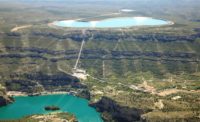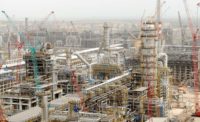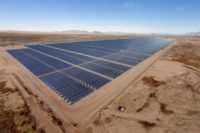Solar power generation is on a roll, propelled by the plummeting costs of photovoltaic (PV) panels and a wide array of incentive programs.
The global solar market had a record year in 2015, adding 55 GW worth of installed capacity, according to a recent report by GTM Research. At the end of 2015, total installed global solar power capacity reached 227 GW, according to Bloomberg New Energy Finance. The GTM report also forecast that another 66 GW will be added in 2016. "We continue to expect stable, steady growth of the solar industry,” says John Smirnow, secretary-general of the Global Solar Council, a lobbying organization for the solar power industry whose membership comprises national and regional associations from around the world. The council has set a goal of 10 million direct solar industry jobs by 2030.
“Solar is a young industry,” says Smirnow. “Some countries have just started embracing solar. Governments are pouring billions of dollars into investments in solar.”
China installed 18 GW of solar PV power plants last year, bringing its total to 48 GW and passing Germany for most installed PV power capacity. Germany, now at No. 2, has approximately 38 GW, followed by Japan (37 GW) and the U.S. (26 GW). New solar power installations in 2015 received $161 billion in investment, according to the Renewables 2016 Global Status Report, issued by REN21, or the Renewable Energy Policy Network for the 21st Century. Twenty-two countries had at least enough solar power capacity at the end of 2015 to meet more than 1% of their electricity demand, according to the report. The three leading nations, in terms of installed solar capacity as a proportion of total electricity demand, were Italy (7.8%), Greece (6.5%) and Germany (5.9%).
“Feed-in tariffs have been one of the critical incentive measures for the growth of solar power,” says Smirnow. Feed-in tariffs mandate that solar and other renewable-energy generators, including homeowners, business owners and private investors, be paid a cost-based price for the electricity they supply to the grid. Feed-in tariff policies have been enacted in more than 50 countries.
Manfred Engelhard, technology manager for energy at M+W Central Europe GmbH, says he “sees three good reasons for the success of PV solar now: One, falling prices for installation and operation of the systems; two, easiness of system ownership and operation, no moving parts, easy to maintain, quite predictable in power output; and three, scalability.”
M+W has completed over 700 MW of solar projects since 2002, including over 500 MW in the U.S. since 2013. One of the largest, a 55-MW solar project in the Negev Desert in Israel, presented certain challenges relating to the single-axis trackers. “Adjusting the trackers to the optimum based on the given parameters—such as module distance, height difference and installation angle—was quite a bit of work in the commissioning phase,” said Engelhard.
Engelhard sees Asia and the Middle East as promising regions for solar power work. “Countries in Asia will develop [solar] since they often suffer a high power price, which PV can easily undercut. We are currently negotiating for several PV projects there—mostly large rooftop arrays."
He also offers his perspective on solar project delivery trends. “We recognize that the EPC contractors and the solar-power developers are working closer together, since we are more often involved in the financing part of PV projects now. M+W is able to support not only an EPC model but also lease models, or we can even step into the investment together with co-financing banks to be the company which sells the power. This role supporting the independent power producer is much appreciated by solar power developers,” Engelhard notes.
In contrast to most other countries, feed-in tariffs play a very limited role in the U.S. The primary drivers of solar-power investment in the U.S. are the federal investment tax credit (ITC) and renewable portfolio standards. The ITC had been scheduled to drop to 10% from 30% in January 2017. But in December 2015, Congress passed an extension keeping it at 30% through 2020.
“The long-term extension of the ITC will not only support continued solar demand, it will also give firms serving the industry the long-term visibility they need to invest in their solar business,” says Justin Baca, vice president of markets and research at the Solar Energy Industries Association. “This year, solar will be the largest single source of new generating capacity of any kind [in the U.S.]. “The cost of electricity from a new solar plant can be lower than the cost of electricity from a new natural-gas plant."
“What we see also in the U.S. are procurements driven by renewable portfolio standards,” says Baca. "Utilities are issuing RFPs to procure solar on a competitive basis. A bunch of solar companies will bid on projects in Texas, Nevada, California and Arizona. We’re seeing incredibly low prices.”
Amec is building Mesquite Solar 2 and 3, a 345-MW solar plant in Arizona, for Sempra, It features panels made by Trina Solar and Jinko Solar. “We’re starting to see quite a bit of opportunity for next year. We’re signing some and negotiating others,” says Tom Dodson, president of power and process in the Americas for Amec Foster Wheeler, the leading solar power contractor in the U.S., according to ENR’s Top 400 Contractors.
Another major segment of the solar PV market is represented by so-called third-party developers, which take two forms. One is the power-purchase-agreement model, in which the installer-developer builds a solar system on a homeowner’s property at no cost to the homeowner-customer. The solar energy produced offsets the customer’s electric utility bill, and the developer sells the power generated to the customer at a fixed rate, usually lower than the local utility's. Another model is based on leasing: The customer contracts with the installer-developer and pays for the solar system over years or decades.
One of the largest third-party solar developers is SolarCity, which also manufactures panels. The 13,000-employee company has installed 2.17 GW of solar systems, including 870 MW in 2015, in 27 states during its decade of operation.
“We expand into states where we can offer solar at a lower cost than the current electricity rate,” says Jonathan Bass, vice president of communications for SolarCity. “Net metering is currently available in over 40 states and is in effect for the states we serve. While electricity rates vary by state, areas that have a higher electricity rate provide better economics for solar, allowing solar customers to pay for their solar energy at a lower price than provided by their local utility.”
World Projects Examples
Many large solar PV projects are being developed around the world.
The Quaid-e-Azam Solar Power Park, located in Pakistan’s Cholistan Desert, already is producing 100 MW of power. Built by China’s Xinjiang SunOasis, it started supplying the national grid in August 2015. The second, 300-MW stage was constructed by China’s Zonergy, with a workforce of 2,000; it was expected to go on line in December 2015. The final, 600-MW phase is expected to be completed by 2017, which would make it the largest solar PV power plant in the world.
The Solar Energy Corporation of India Ltd., a unit of the Ministry of New and Renewable Energy, is planning on building one of the largest solar power plants in the world, with a capacity of 750 MW, in Madhya Pradesh. Spread over 3,750 acres, it will be developed in three phases of 250 MW each. The Delhi Metro Rail Corp. is expected to sign a power purchase agreement for 150 MW, with the remaining capacity procured by the state utility. Electricity generation from the first phase is expected to start in June 2017.
The introduction of feed-in tariffs in Egypt in 2014 has spurred interest from 180 firms seeking to develop solar and wind projects. The largest solar scheme being developed includes 2,000 MW of power plants as well as a photovoltaic-module manufacturing plant. The developer, Terra Solar Ventures, Bahrain, is composed of Swiss wealth management firm Terra Nex, RWE New Energy, Hareon Solar Technologies and a number of German tech companies. In 2015, Terra Sola signed an agreement with the Egyptian Electricity Holding Co.
Terra Nex will manage a fund made up of German investors to finance the projects, with Hareon supplying the solar modules and RWE operating the power plants. The overall project is expected to bring $3.5 billion of direct investment to Egypt and create 50,000 jobs.
The largest solar PV power plant operating in Latin America is the 160-MW Finis Terrae plant in Chile. It was built by Enel Green Power Chile at a cost of $270 million. Enel Green Power is constructing the Ituverava solar farm in Brazil; it has a capacity of 254 MW and is expected to be completed by late 2017. Acciona Energia is building the 247-MW El Romero Solar plant in Chile’s Atacama Desert; it is expected to go on line in 2017.
Mexico conducted is first electricity auction in March 2016, choosing seven solar and wind companies to receive 15-year contracts to develop and sell power to the state-owned utility Comision Federal de Electricidad (CFE). The largest contract went to Enel Green Power, Italy, to develop three solar PV plants at an investment of $1 billion. Two of the plants—the 427-MW Villanueva and the 327-MW Villanueva 3—will be located in the state of Coahuila, and the 238-MW Don Jose plant will be situated in the state of Guanajuato. The plants are expected to begin operating by 2018.














